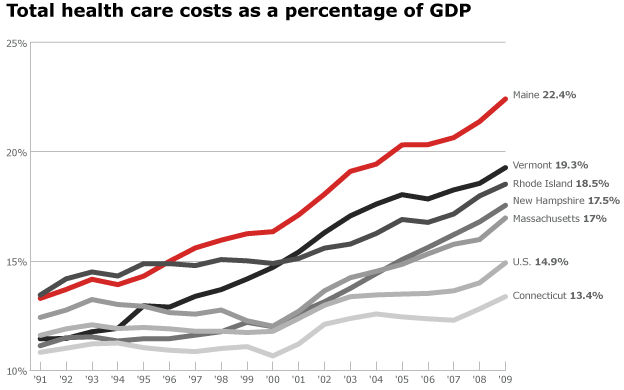Health care remains top concern
 Source: Kaiser Family Foundation and U.S. Bureau of Economic Analysis
Source: Kaiser Family Foundation and U.S. Bureau of Economic Analysis
An annual report from the Maine Economic Growth Council once again lists health care costs as one of the most problematic issues facing Maine businesses.
While notable gains were made in the areas of international exports and cost of energy, the council's Measures of Growth in Focus report, compiled with the help of the Maine Development Foundation, gave red flag status to five economic indicators: research and development expenditures; fourth-grade reading scores; transportation infrastructure; cost of health care; and wellness and prevention.
Each of these indicators, except transportation infrastructure, also appeared on last year's red flag list. Since last year, six economic indicators moved away from their aspirational benchmarks, four moved closer and 15 made no discernible movement in either direction.
"No one indicator tells the whole story or should be the sole focus, but all 25 have a very real effect on Maine business both large and small," says Ed Cervone, senior program director with MDF.
In measuring total health care costs as a percent of GDP, Maine led all New England states at 22.4%, up from 13.3% in 1991. Currently 7.3% higher than the national average and 4.4% above the New England average, Maine's health care expenditures are an ongoing concern within the state's business community, who ranked high health care costs as the top obstacle to investment and growth in a 2010 MDF survey.
Per capita health care expenditures have been rising throughout the country over the last decade, increasing 65% from 2000 to 2009. This trend has been exacerbated in Maine where the high cost of care and a relatively smaller economy have contributed to an 83% rise over the same period, from $4,656 in 2000 to $8,521 in 2009.
While no one factor can explain the high cost of health care in Maine, Cervone says demographics and density play a large part. "Given the older, rural, low-density nature of the state, it just costs more to deliver the same type of service in a place with fewer people," Cervone says.
The opaque pricing structure governing medical services also contributes to the cost, according to Cervone. "You can look at a pricing list of same service and there is a huge variation. For example, the cost of MRI in this state can range greatly depending on where you are getting it done, the time of day and who is in room; it doesn't necessarily match up with low- or high-population density," Cervone says.
"The cost of health care is the number one issue in Maine and across the country. It's a big impediment to being competitive with other businesses and attracting qualified workers," says David Clough, executive director of Maine's chapter of the National Federation of Independent Business.
The cost is particularly prohibitive in a state where over 90% of businesses are considered "small," according to Clough. "Health care is a benefit a lot of small businesses want to offer, but they have a smaller base to spread that cost over and less flexibility for absorbing costs."
Only 42% of Maine's small businesses (100 or fewer employees) contribute to employees' coverage, according to the 2009 Maine Small Business Healthcare Survey. Eight-one percent of those offering health insurance say they are struggling to do so.
Legislative measures like the federal Affordable Care Act and the state's public law 90, which will allow regional insurers to offer individual policies in Maine without subjecting them to state's benefit requriements, are attempts to rein in health care costs. The Maine Bureau of Insurance predicts 80% of individuals would experience lower premiums following the implementation of PL 90, which will also offer a tax credit for employers who institute a company wellness program.
The ACA is currently under review by the Supreme Court, but some insurers have begun adopting it. "One of the things I'm noticing is that insurance companies are complying with the [ACA] and have eliminated co-payments for preventive care — that's a great step in the right direction," says Dr. Wendy Wolf, president and CEO of the Maine Health Access Foundation.
The MHAF promotes cost-saving initiatives and identifies trends in how Mainers use health care. "Some of these activities draw on the payment reform initiatives being advanced through the [ACA] and some initiatives are a little bit more idiosyncratic to Maine like how to promote more cost-effective prescribing practices," says Wolf.
One such initiative of the MHAF has a grant-recipient working with insurance brokers in Somerset County to develop a wellness program for micro-businesses of fewer than five employees.
Getting out in front of health problems is an easy way to defray costs as well as productivity, according to Cervone. "If you spend a little upfront relative to other expenses, [employees] will produce more, be happier and not be making the health care claims at the level they were before," he says. "It also has the benefit of showing your employees you care about them."
Editor's note: This story was corrected May 7, 2012, to reflect that 80% of individuals would experience lower premiums following the implementation of PL 90, not that individuals would see an 80% reduction. We regret the error.










Comments